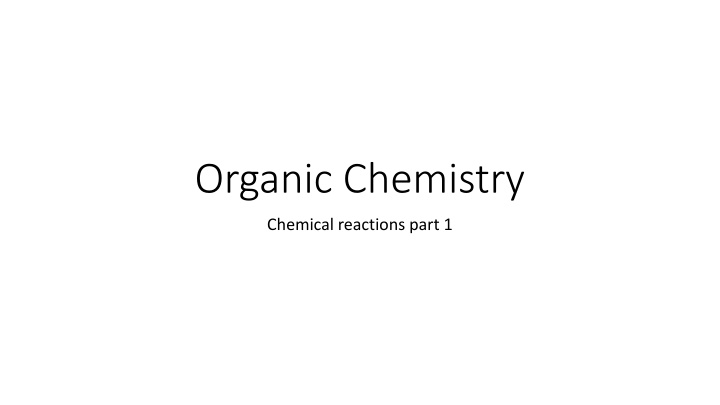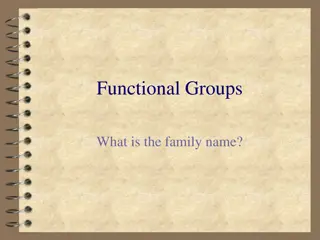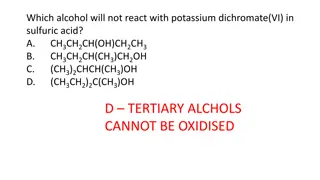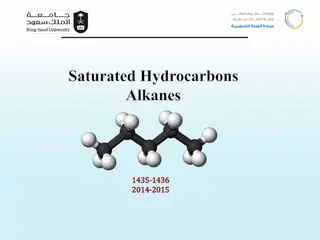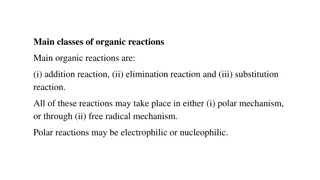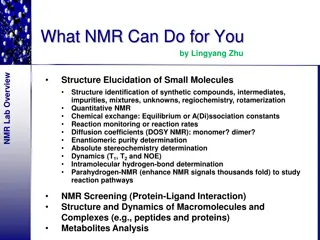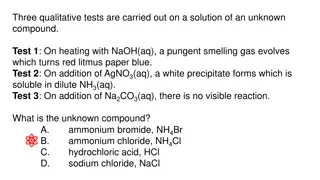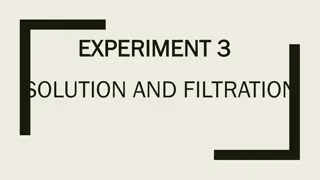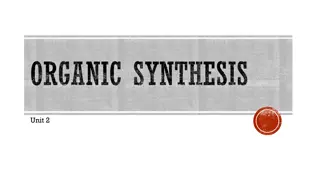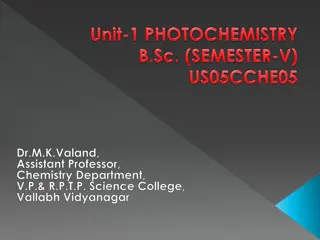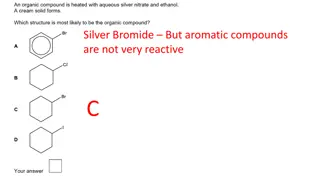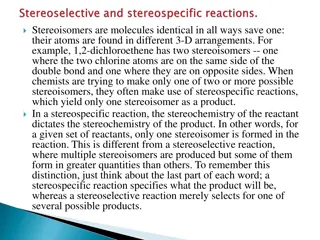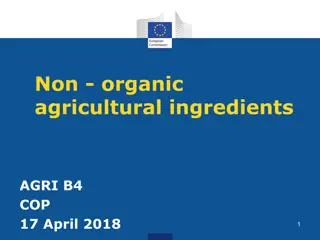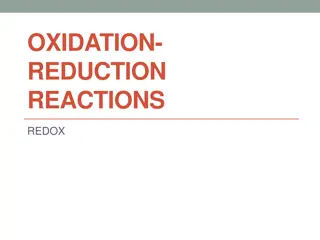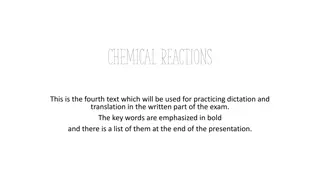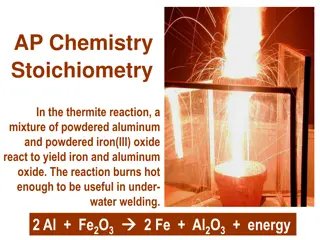Organic Chemistry: Alkanes and Haloalkanes Reactions
Alkanes undergo combustion reactions leading to either complete or incomplete combustion processes releasing energy. Haloalkanes are formed through various methods such as free radical substitution or electrophilic addition, with different levels of carbon attachments determining primary, secondary, or tertiary halogenoalkanes.
Download Presentation

Please find below an Image/Link to download the presentation.
The content on the website is provided AS IS for your information and personal use only. It may not be sold, licensed, or shared on other websites without obtaining consent from the author.If you encounter any issues during the download, it is possible that the publisher has removed the file from their server.
You are allowed to download the files provided on this website for personal or commercial use, subject to the condition that they are used lawfully. All files are the property of their respective owners.
The content on the website is provided AS IS for your information and personal use only. It may not be sold, licensed, or shared on other websites without obtaining consent from the author.
E N D
Presentation Transcript
Organic Chemistry Chemical reactions part 1
Alkanes chemical reactions Combustion Free radical substitution
Complete combustion In excess oxygen, short chain alkanes can undergo complete combustion: alkane + oxygen carbon dioxide + water For example: propane + oxygen carbon dioxide + water C3H8(g) + 5O2(g) 3CO2(g) + 4H2O(g) The combustion of alkanes is a highly exothermic process. This makes them good fuels because they release a relatively large amount of energy per gram of fuel. forward_arrow_colour
Incomplete combustion If oxygen is limited then incomplete combustion will occur: alkane + oxygen carbon monoxide + water alkane + oxygen carbon + water For example: propane + oxygen carbon monoxide + water C3H8(g) + 3 O2(g) 3CO(g) + 4H2O(g) propane + oxygen carbon + water C3H8(g) + 2O2(g) 3C(s) + 4H2O(g) forward_arrow_colour
Haloalkanes Making haloalkanes and reactions they can take part in
Primary, secondary and tertiary A chain of carbon atoms can be represented by R when drawing the structure. This is referred to as an R group. Primary (1 ) halogenoalkanes have one R group attached to the carbon linked to the halogen. Secondary (2 ) halogenoalkanes have two R groups attached to the carbon linked to the halogen. Tertiary (3 ) halogenoalkanes have three R groups attached to the carbon linked to the halogen. forward_arrow_colour
How are halogenoalkanes made? There are several ways by which halogenoalkanes can be made, including: free radical substitution of an alkane: CH4 + Cl2 CH3Cl + HCl electrophilic addition of HX or X2 to an alkene: C2H4 + HBr C2H5Br C2H4 + Br2 C2H4Br2 forward_arrow_colour
Free radical substitution: Cl2 + CH4 forward_arrow_colour
Other products of chain reactions If an alkane is more than two carbons in length then any of the hydrogen atoms may be substituted, leading to a mixture of different isomers. For example: 1-chloropropane 2-chloropropane The mixture of products is difficult to separate, and this is one reason why chain reactions are not a good method of preparing halogenoalkanes. forward_arrow_colour
Further substitution in chain reactions Some chloromethane molecules formed during free radical substitution between methane and chlorine will undergo further substitution to form dichloromethane. Further substitution can occur until all hydrogens are substituted. The further substituted chloroalkanes are impurities that must be removed. The amount of these molecules can be decreased by reducing the proportion of chlorine in the reaction mixture. forward_arrow_colour
Polar bonds and nucleophiles The carbon halogen bond in halogenoalkanes is polar because all halogens are more electronegative than carbon. + - + - + - + - The polar bond means that the carbon atom has a small positive charge ( +), which attracts substances with a lone pair of electrons. These are nucleophiles, meaning nucleus (positive charge) loving . Examples include: ammonia hydroxide cyanide forward_arrow_colour
Reaction with nucleophiles Nucleophiles (Nu-) attack the carbon of a carbon halogen (C X) bond, because the electron pair on the nucleophile is attracted towards the small positive charge on the carbon. + - The electrons in the C X bond are repelled as the Nu- approaches the carbon atom. The Nu- bonds to the carbon and the C X bond breaks. The two electrons move to the halogen, forming a halide ion. The halide is substituted, so this is a nucleophilic substitution reaction. forward_arrow_colour
Nucleophilic substitution reactions forward_arrow_colour
Alkenes Combustion reactions Addition reactions Polymerisation reactions
Complete combustion In excess oxygen, short chain alkenes can undergo complete combustion: alkene + oxygen carbon dioxide + water For example: propene + oxygen carbon dioxide + water C3H6(g) + 4 O2(g) 3CO2(g) + 3H2O(g) The combustion of alkanes is a highly exothermic process. This makes them good fuels because they release a relatively large amount of energy per gram of fuel. forward_arrow_colour
Incomplete combustion If oxygen is limited then incomplete combustion will occur: alkene + oxygen carbon monoxide + water alkene + oxygen carbon + water For example: propene + oxygen carbon monoxide + water C3H6(g) + 3O2(g) 3CO(g) + 3H2O(g) propene + oxygen carbon + water C3H6(g) + 1 O2(g) 3C(s) + 3H2O(g) forward_arrow_colour
Double bonds and electrophiles The double bond of an alkene is an area of high electron density, and therefore an area of high negative charge. The negative charge of the double bond may be attacked by electron-deficient species, which will accept a lone pair of electrons. These species have either a full positive charge or slight positive charge on one or more of their atoms. They are called electrophiles, meaning electron loving . Alkenes undergo addition reactions when attacked by electrophiles. This is called electrophilic addition. forward_arrow_colour
Electrophilic addition mechanism: 1 In the first stage of electrophilic addition, the positive charge on the electrophile is attracted to the electron density in the double bond. + - As the electrophile approaches the double bond, electrons in the A B bond are repelled towards B. The pi bond breaks, and A bonds to the carbon, forming a carbocation an ion with a positively-charge carbon atom. The two electrons in the A B bond move to B forming a B- ion. forward_arrow_colour
Electrophilic addition mechanism: 2 In the second stage of electrophilic addition, the B- ion acts as a nucleophile and attacks the carbocation. The lone pair of electrons on the B- ion are attracted towards the positively- charged carbon in the carbocation, causing B to bond to it. Because both electrons in the bond that joins B- to the carbocation ion come from B-, the bond is a co-ordinate bond. forward_arrow_colour
What is hydrogenation? Hydrogen can be added to the carbon carbon double bond using a nickel catalyst in a process called hydrogenation. C2H4 + H2 C2H6 Vegetable oils are unsaturated and may be hydrogenated to make margarine, which has a higher melting point. As well as a nickel catalyst, this requires a temperature of 200 C and a pressure of 1000kPa. forward_arrow_colour
Testing for alkenes The presence of unsaturation (a carbon carbon double bond) can be detected using bromine water, a red/orange coloured solution of bromine. A few drops of bromine water are added to the test liquid and shaken. If a carbon carbon double bond is present, the bromine adds across it and the solution turns colourless. forward_arrow_colour
More on the bromine water test A simple equation for the bromine water test with ethene is: CH2=CH2 + Br2 + H2O CH2BrCH2Br + H2O However, because water is present in such a large amount, a water molecule (which has a lone pair) adds to one of the carbon atoms, followed by the loss of a H+ ion. CH2=CH2 + Br2 + H2O CH2BrCH2OH + HBr The major product of the test is not 1,2-dibromoethane (CH2BrCH2Br) but 2-bromoethan-1-ol (CH2BrCH2OH). forward_arrow_colour
Electrophilic addition reactions forward_arrow_colour
Addition to unsymmetrical alkenes When an electrophile (e.g. HBr) attacks an alkene with three or more carbon atoms (e.g. propene), a mix of products is formed. This is because these alkenes are unsymmetrical. HBr minor product: 1-bromopropane major product: 2-bromopropane Unequal amounts of each product are formed due to the relative stabilities of the carbocation intermediates. forward_arrow_colour
Structure of carbocations A chain of carbon atoms can be represented by R when drawing organic structures. This is an alkyl group (general formula CnH2n+1). Primary (1 ) carbocations have one alkyl group attached to the positively-charged carbon. Secondary (2 ) carbocations have two alkyl groups attached to the positively-charged carbon. Tertiary (3 ) carbocations have three alkyl groups attached to the positively-charged carbon. forward_arrow_colour
Stability of carbocations The stability of carbocations increases as the number of alkyl groups on the positively-charged carbon atom increases. secondary tertiary primary increasing stability The stability increases because alkyl groups contain a greater electron density than hydrogen atoms. This density is attracted towards, and reduces, the positive charge on the carbon atom, which has a stabilizing effect. forward_arrow_colour
Structure of carbocations forward_arrow_colour
Polyalkenes Alkenes can undergo addition reactions with themselves to form a long chain polymer molecule. This reaction is addition polymerization. The polymer can be represented by showing the repeating unit with square brackets around it. The n stands for a unspecified number of monomer units. forward_arrow_colour
Polymerization of ethene forward_arrow_colour
LDPE and HDPE The reaction conditions under which ethene polymerizes affect the structure and properties of the poly(e)thene. Low-density polythene (LDPE) is formed under a high pressure (1400atm) and a temperature of about 170 C. These conditions cause a high level of branching, meaning that the polymer chains cannot pack tightly together. High-density polythene (HDPE) is formed with a catalyst, a pressure of 2atm and a temperature of about 70 C. Little branching occurs under these conditions, resulting in chains that can pack tightly together to create a denser material. forward_arrow_colour
Other polyalkenes Propene undergoes addition polymerization to form polyproprene: Chloroethene undergoes addition polymerization to form polychloroethene: forward_arrow_colour
Which alkene? forward_arrow_colour
